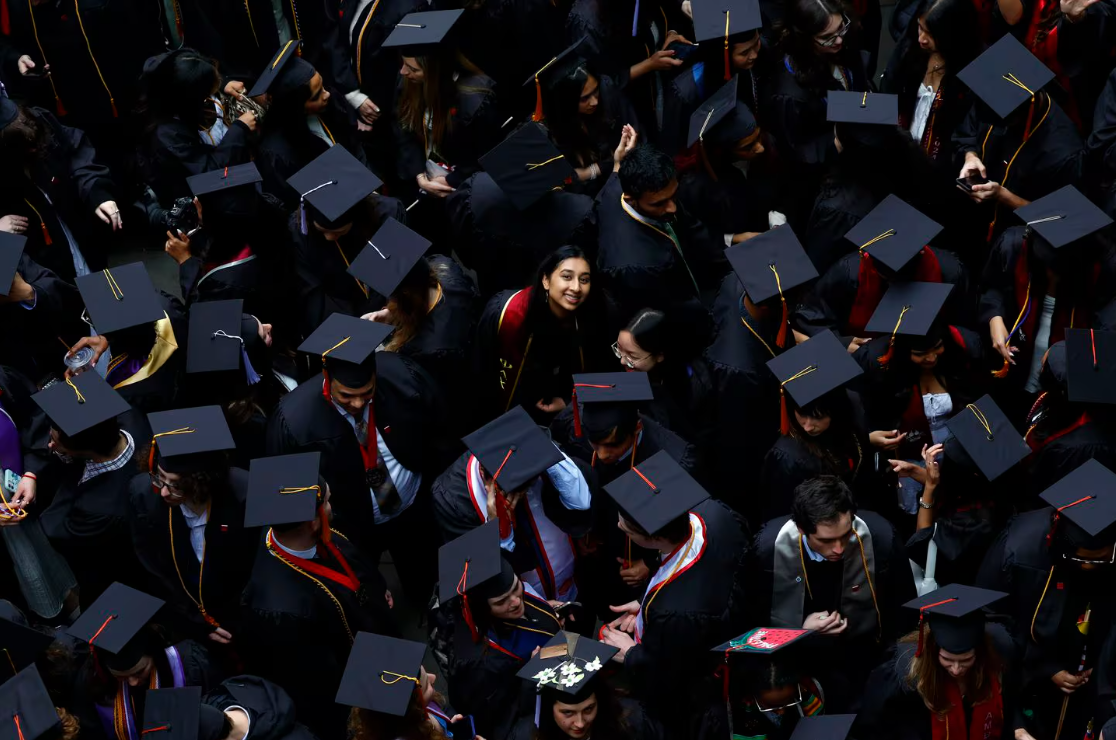美国大学的国际毕业生应该能更容易的留下来 扩大 H1-B 签证计划可以鼓励技术工人的涌入

【中美创新时报2024 年 5 月 26 日编译讯】(记者温友平编译)美国大学毕业生、能够为国家生产力和税基做出贡献的技术工人都是潜在的移民;美国人应该张开双臂欢迎他们。对此,《波士顿环球报》编委会发表了下述社论文章。
据 OpenDoors 称,国际学生是我们高等教育体系的重要组成部分,2022-2023 年将有近 80,000 名国际学生在马萨诸塞州的学院和大学就读。但毕业后,很多人都离开了。据希利政府称,马萨诸塞州仅留住了 66% 的国际毕业生。
许多毕业生离开并不是因为他们想离开,而是因为破碎的移民制度让他们很难留下来。
每一个离开的人都代表着一次失去的机会。美国大学毕业生、能够为国家生产力和税基做出贡献的技术工人都是潜在的移民;美国人应该张开双臂欢迎他们。
他们可能是国家需要的科学家和工程师。根据美国政策国家基金会 2017 年的一份政策简报,外国公民约占美国石油工程、电气工程或计算机科学专业研究生的 80%。
H-1B 签证计划的扩展为“特殊”职业的工人提供签证,将允许更多的国际毕业生留下来。H-1B 签证通常用于技术领域,但适用于一系列至少需要学士学位的职业。雇主需要担保工人获得 H-1B 签证。
从长远来看,联邦政府还应该清理积压的绿卡,以便在这里开始职业生涯的技术工人能够留下来。
通常,美国大学的国际毕业生可以通过名为“可选实践培训”的计划申请在美国工作一年(三年,获得科学、技术、工程或数学学位)。如果他们想停留更长时间,最常见的途径是申请 H-1B 签证。但需求超过供应。
1990年,国会将每年发放的H-1B签证数量限制在65,000个。2005年,国会为美国院校的硕士学位毕业生额外发放了2万个签证。
今年 4 月,美国公民及移民服务局宣布,雇主登记了 470,342 名签证计划的潜在受益人,其中 120,603 人通过抽签方式申请(移民局随后将审查他们的资格)。
卡托研究所(Cato Institute)移民研究主任大卫·比尔(David Bier)表示,缺乏签证导致毕业生进入OPT工作、申请H-1B抽签、没有获得签证、获得硕士学位、然后再次工作的循环。在OPT期间再次尝试抽签。 “试图经历这一切真是令人筋疲力尽,”比尔说。
而且,比尔说,这没有意义。“作为一个国家,我们的目标是什么?” 他问。“教育世界,然后送他们去其他地方创建公司和就业机会?”
Vrinda Punj 是居住在新罕布什尔州纳舒厄的印度国民,她 6 岁时移居美国,因为她的父亲是一名商业分析师,拥有 H-1B 签证。她于 2021 年从马萨诸塞州洛厄尔大学毕业,获得计算机科学学位,但成年后不再受到她父亲签证的保护。她在一家愿意赞助她签证的公司找到了一份软件工程工作,然后不得不参加抽签。“你可以尽一切努力留在这里……但不能保证你能在美国拥有任何未来,”旁杰说。“感觉好像我的一生、我的整个未来都依赖于随机的机会。”
有一些方法可以解决这个问题。国会可以增加 H-1B 签证的数量,或者为美国大学毕业生或寻求创业的企业家增加额外的签证。每年还有数十万张绿卡因行政问题而闲置。尼斯卡宁中心估计,拜登政府可以通过允许使用这些签证来“夺回”231,000个就业签证,而不是在年底未使用时将其丢弃。这将涉及计算前几年未使用的签证数量并将其分配给新申请人。尼斯卡宁中心表示,如果国会采取某些政策,影响计算未使用签证数量的方法,则可能会使用更多签证。
对于那些有幸获得 H-1B 签证的人来说,该签证的有效期最长为六年——不过,如果持有者申请了绿卡并正在等待,签证可以续签更长的时间。要获得永久居留权,工人必须申请绿卡。但该系统也积压了。2023年3月,有180万人等待就业绿卡。由于绿卡是按国家分配的,而等待绿卡的人中有 110 万人来自印度,根据卡托研究所的分析,印度国民理论上的等待时间可能为 134 年,换句话说,这是不可能的。
虽然工人在绿卡申请等待期间可以无限期续签 H-1B 签证,但孩子只能在 21 岁之前继续持有父母的签证。Dip Patel 是为帮助这一群体而创立 Improve The Dream 的人,他估计还有更多 现在美国有超过 200,000 人小时候被临时签证持有者带到这里。“对于他们中的许多人来说,获得公民身份的唯一途径是与美国公民结婚,因为其他一切要么被阻碍,要么积压,”帕特尔说。允许这些儿童中的许多人获得绿卡的立法在国会陷入停滞。
有一些创造性的解决方法。州长莫拉·希利 (Maura Healey) 提议投入 22 万美元用于扩大全球企业家驻地计划,该计划允许大学资助毕业生企业家,因为大学不受 H-1B 签证上限的限制。 但这是一个狭隘的解决方案。
麻省大学波士顿分校创业发展中心退休主任威廉·布拉(William Brah)在帕特里克执政期间启动了该计划的初步试点,他表示,大学只能资助其业务与其使命相关的企业家。这也是一种短期赞助,通常为期一到两年,之后接受者必须申请另一个签证。布拉表示,他的试点计划在五年内帮助了大约 100 名毕业生。
“国际学生有竞争。[美国大学]花费数十亿美元来培训他们,”布拉说。“他们中的很多人怀着创业意向而来,非常兴奋,希望有机会在美国创建一家公司,但他们做不到。”
唯一真正的解决方案是国会的行动。由于担心移民会抢走美国出生的工人的工作,一些政治人士反对扩大签证计划。但研究表明,外国出生的技术工人的存在增加了美国出生的工人的就业机会。立法也被推迟,因为增加 H-1B 签证会增加税收。这是一件好事,但国会长期以来一直将这笔钱视为支付更广泛的移民改革费用的一种方式,但国会一直无法就改革细节达成一致。
将绿卡钉在大学毕业生文凭上的想法过于简单化。但其背后的原则——让在美国接受培训的技术工人有机会为美国经济做出贡献——是很有意义的。
题图:毕业生们在芬威公园球场前排队参加东北大学 2024 届毕业典礼。DANIELLE PARHIZKARAN/GLOBE 工作人员
附原英文报道:
International graduates of US colleges should have an easier path to stay
Expanding the H1-B visa program could encourage an influx of skilled workers.
By The Editorial Board Updated May 26, 2024
Graduates lined up before walking onto the field at Fenway Park for the Northeastern University class of 2024 commencement.DANIELLE PARHIZKARAN/GLOBE STAFF
International students are a vital part of our higher education system, with nearly 80,000 international students attending Massachusetts colleges and universities in 2022-2023, according to OpenDoors. But after graduation, many of them leave. According to the Healey administration, Massachusetts retains just 66 percent of its international graduates.
Many graduates leave not because they want to but because a broken immigration system makes it too hard for them to stay.
Each one who leaves represents a lost opportunity. Graduates of US colleges, skilled workers who could contribute to the country’s productivity and tax base, are potential immigrants; Americans should welcome them with open arms.
They could be the scientists and engineers the country needs. According to a 2017 policy brief by the National Foundation for American Policy, foreign nationals accounted for about 80 percent of US graduate students studying petroleum engineering, electrical engineering, or computer science.
An expansion of the H-1B visa program, which offers visas to workers in “specialty” occupations, would allow more international graduates to stay. H-1B visas are often used in technology fields but apply across a range of occupations that require at least a bachelor’s degree. An employer needs to sponsor a worker for an H-1B visa.
Long term, the federal government also should clear the green card backlog so skilled workers who start their careers here can stay.
Typically, an international graduate of a US college can apply to work in the United States for one year (three years with a degree in science, technology, engineering, or math) through a program called Optional Practical Training. If they want to stay longer, the most common path is to apply for an H-1B visa. But demand outstrips supply.
In 1990, Congress capped at 65,000 the number of H-1B visas issued annually. In 2005, Congress allocated an additional 20,000 visas for master’s degree graduates of US institutions.
This April, US Citizenship and Immigration Services announced that employers registered 470,342 potential beneficiaries for the visa program, of whom 120,603 were chosen via a lottery to apply (immigration services would then review their qualifications).
David Bier, director of immigration studies at the Cato Institute, said the lack of visas leads to a cycle where graduates work on OPT, apply for the H-1B lottery, don’t get a visa, earn a master’s degree, then work again on OPT while trying the lottery again. “It’s exhausting trying to go through it,” Bier said.
And, Bier said, it doesn’t make sense. “What’s our goal as a country?” he asked. “To educate the world, then send them on their way to create companies and jobs in other places?”
Vrinda Punj is an Indian national living in Nashua, N.H., who moved to the United States at age 6 because her father, a business analyst, had an H-1B visa. She graduated from the University of Massachusetts Lowell in 2021 with a computer science degree, but as an adult was no longer covered by her father’s visa. She found a job in software engineering with a company that was willing to sponsor her visa, then had to enter the lottery. “You can try to do literally everything in your power to stay here … but there is no guarantee you can have any sort of future in the US,” Punj said. “It felt as though my entire life, my entire future was dependent on random chance.”
There are ways to address this. Congress could increase the number of H-1B visas or add additional visas for graduates of US colleges or entrepreneurs seeking to start businesses. There are also hundreds of thousands of green cards that have gone unused each year due to administrative issues. The Niskanen Center estimates the Biden administration could “recapture” 231,000 employment-based visas by allowing the use of these visas, rather than discarding them if they are unused at the end of a year. This would involve calculating the number of visas that went unused in previous years and giving them to new applicants. The Niskanen Center says more visas could be used if Congress adopted certain policies that would affect the methdology for calculating how many visas have gone unused.
For those lucky enough to get an H-1B visa, it lasts up to six years — although a visa can be renewed for longer if the holder applied for a green card and is waiting. To get permanent residency, a worker must apply for a green card. But that system is also backlogged. In March 2023, there were 1.8 million people awaiting employment-based green cards. Because green cards are apportioned by country and 1.1 million of those waiting are from India, the theoretical wait time for an Indian national could be 134 years, according to the Cato Institute’s analysis — in other words, impossible.
While a worker can get their H-1B visa renewed indefinitely while their green card application is pending, a child can only remain on a parent’s visa until age 21. Dip Patel, who founded Improve The Dream to help this population, estimates there are more than 200,000 people in the United States now who were brought here as a child by temporary visa-holders. “For many of them, the only pathway to citizenship is marrying a US citizen, because everything else is either roadblocked or backlogged,” Patel said. Legislation that would let many of these children obtain green cards stalled in Congress.
There are creative workarounds. Governor Maura Healey proposed putting $220,000 toward expanding a Global Entrepreneur in Residence program that allows universities to sponsor graduate entrepreneurs, since universities are exempt from the H-1B visa cap. But this is a narrow solution.
William Brah, retired director of the Venture Development Center at UMass Boston, which launched an initial pilot of this program during the Patrick administration, said universities can only sponsor entrepreneurs whose businesses are relevant to their mission. It’s also a short-term sponsorship, generally for one to two years, after which recipients must apply for another visa. Brah said his pilot program helped about 100 graduates over five years.
“There’s competition for international students. [US colleges] spend billions of dollars training them,” Brah said. “A bunch of them come with entrepreneurial intentions, get really fired up and want a chance to create a company in the US, and they can’t do it.”
The only real solution is congressional action. There has been some political opposition to expanding the visa program out of fear immigrants will take jobs from US-born workers. But research suggests the presence of foreign-born skilled workers increases job opportunities for US-born workers. Legislation has also been delayed because increasing H-1B visas would increase tax revenue. That’s a good thing, but Congress has long eyed that pot of money as a way to pay for a broader immigration reform — the details of which it has been unable to agree on.
The idea of stapling a green card to a college graduate’s diploma is simplistic. But the principle behind it — giving US-trained skilled workers a chance to contribute to the US economy — makes a lot of sense.

